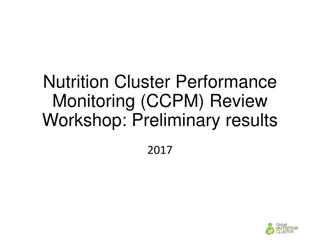Swarm on the Biowulf2 Cluster
Swarm is a wrapper script designed to facilitate running individual commands on a cluster environment like Biowulf. This tool streamlines job execution by allocating cores instead of nodes, ensuring all resources are efficiently utilized. The provided images and explanations shed light on the architecture, differences in Biowulf versions, basic usage, standard options, and autothreading features of Swarm.
Download Presentation

Please find below an Image/Link to download the presentation.
The content on the website is provided AS IS for your information and personal use only. It may not be sold, licensed, or shared on other websites without obtaining consent from the author.If you encounter any issues during the download, it is possible that the publisher has removed the file from their server.
You are allowed to download the files provided on this website for personal or commercial use, subject to the condition that they are used lawfully. All files are the property of their respective owners.
The content on the website is provided AS IS for your information and personal use only. It may not be sold, licensed, or shared on other websites without obtaining consent from the author.
E N D
Presentation Transcript
Swarm on the Biowulf2 Cluster Dr. David Hoover, SCB, CIT, NIH staff@hpc.nih.gov September 24, 2015
What is swarm? Wrapper script that simplifies running individual commands on the Biowulf cluster
Documentation 'man swarm' 'swarm --help' https://hpc.nih.gov/apps/swarm.html
Differences in Biowulf 1 -> 2 Jobs are allocated cores, rather than nodes All resources must be allocated All swarms are job arrays
Architectural Digest nod e socket core cpus, hyperthreads
Simple swarm swarm 2 1 3 0 0 hostname ; uptime swarm -t 2 subjobs 1 hostname ; uptime 2 hostname ; uptime 3 hostname ; uptime single-threaded swarm
Simple swarm swarm -t 3 1 2 3 0 0 hostname ; uptime swarm -t 4 subjobs 1 hostname ; uptime 2 hostname ; uptime 3 hostname ; uptime multi-threaded swarm
Basic swarm usage Create swarmfile (file.swarm) cd /home/user/dir1 ; ls l cd /home/user/dir2 ; ls l cd /home/user/dir3 ; ls l cd /home/user/dir4 ; ls -l Submit and wait for output $ swarm f file.swarm 1234567 $ ls swarm_1234567_0.o swarm_1234567_1.o swarm_1234567_2.o swarm_1234567_0.e swarm_1234567_1.e swarm_1234567_2.e
Standard swarm options -f : swarmfile, list of commands to run -g : GB per process (NOT PER NODE OR JOB!) -t : threads/cpus per process (DITTO!) command p 4 i /path/to/input1 o /path/to/output1 command p 4 i /path/to/input2 o /path/to/output2 command p 4 i /path/to/input3 o /path/to/output3 command p 4 i /path/to/input4 o /path/to/output4 $ swarm f file.swarm g 4 t 4
-t auto Autothreading still enabled java Xmx8g jar /path/to/jarfile opt1 opt2 opt3 $ swarm f file.swarm g 4 t auto This allocates an entire node to each process
-b, --bundle Bundling is slightly different swarms of > 1000 commands are autobundled --autobundle is deprecated
--singleout Concatenate all .o and .e into single files Not entirely reliable! CANCELLED and TIMEOUT will lose all output Better to use --logdir (described later)
Miscellaneous --usecsh --no-comment, --comment-char --no-scripts, --keep-scripts --debug, --devel, --verbose, --silent
--devel $ swarm --devel -f file.swarm -b 4 -g 8 -v 4 ------------------------------------------------------------ SWARM subjob 0: 4 commands (1 cpu, 8.00 gb) subjob 1: 4 commands (1 cpu, 8.00 gb) subjob 2: 4 commands (1 cpu, 8.00 gb) subjob 3: 4 commands (1 cpu, 8.00 gb) ------------------------------------------------------------ 4 subjobs, 16 commands, 0 output file 16 commands run in 4 subjobs, each command requiring 8 gb and 1 thread, running 4 processes serially per subjob sbatch --array=0-3 --job-name=swarm -- output=/home/user/test/swarm_%A_%a.o -- error=/home/user/test/swarm_%A_%a.e --cpus-per-task=1 -- mem=8192 --partition=norm --time=16:00:00 /spin1/swarm/user/I8DQDX4O.batch
No more .swarm directories swarm scripts are written to a central, shared area Each user has their own subdirectory $ tree /spin1/swarm/user /spin1/swarm/user 2341529 cmd.0 cmd.1 cmd.2 cmd.3 2341529.batch
--license --license replaces -R or --resource $ swarm f file.swarm --license=matlab
--module --module now requires comma-delimited list, rather than space delimited list: $ swarm f file.swarm --module python,samtools,bwa,tophat
--gres --gres stands for "generic resources" Is used for allocating local disk space Replaces --disk $ swarm f file.swarm --gres=lscratch:50 /lscratch/$SLURM_JOBID Above example gives 50GB of scratch space See https://hpc.nih.gov/docs/userguide.html#local
-p, --processes-per-subjob For single-threaded commands -p can only be 1 or 2 0 2 0 hostname ; uptime swarm -p 2 subjobs 1 3 1 hostname ; uptime 2 hostname ; uptime 3 hostname ; uptime
--logdir Redirects .o and .e files to a directory The directory must first exist $ mkdir /data/user/trashbin $ swarm f files.swarm --logdir /data/user/trashbin 1234567 $ ls file.swarm $ ls /data/user/trashbin swarm_1234567_0.o swarm_1234567_1.o swarm_1234567_2.o swarm_1234567_0.e swarm_1234567_1.e swarm_1234567_2.e
--time All jobs must have a walltime now --time for swarm is per command, not per swarm or per subjob --time multiplied by bundle factor $ swarm -f file.swarm --devel -- 32 commands run in 32 subjobs, each command requiring 1.5 gb and 1 thread, allocating 32 cores and 64 cpus sbatch --array=0-31 ... -- --time=01:00:00 time=01:00:00 /spin1/swarm/hooverdm/iMdaW6dO.batch $ swarm -f file.swarm --devel -- --time=01:00:00 time=01:00:00 - -b 4 32 commands run in 8 subjobs, each command requiring 1.5 gb and 1 thread, running 4 processes serially per subjob sbatch --array=0-7 ... -- --time=04:00:00 time=04:00:00 /spin1/swarm/hooverdm/zYrUbkiO.batch --time=01:00:00 time=01:00:00 b 4
Primary sbatch options --job-name --dependency --time, --gres --partition --qos
ALL sbatch options --sbatch $ swarm -f file.swarm --sbatch "--mail-type=FAIL -- export=var=100,nctype=12 --workdir=/data/user/test" Type 'man sbatch' for more information
--prologue and --epilogue way too difficult to implement conflicts with --prolog and --epilog options to srun
--W block=true sbatch does not allow blocking must use srun instead
-R, --resource gpfs is available on all nodes Replaced by a combination of --license, --gres, and --constraint
Examples single-threaded commands $ swarm f file.swarm multi-threaded commands $ swarm f file.swarm t 4 large memory, single-threaded $ swarm f file.swarm g 32
Examples >10K single-threaded commands $ mkdir /data/user/bigswarm $ swarm f file.swarm --job-name bigswarm --logdir /data/user/bigswarm wait for it and deal with the output ... $ cd /data/user/bigswarm $ cat *.e > bigswarm.err $ cat *.o > bigswarm.out $ rm *.{e,o}
Examples Large temp files export TMPDIR=/lscratch/$SLURM_JOBID ; command opt 1 export TMPDIR=/lscratch/$SLURM_JOBID ; command opt 2 export TMPDIR=/lscratch/$SLURM_JOBID ; command opt 3 export TMPDIR=/lscratch/$SLURM_JOBID ; command opt 4 $ swarm f file.swarm --gres=lscratch:200
Examples Dependencies $ sbatch script_1.sh 10000 $ swarm -f file.swarm --dependency=afterany:10000 10001 $ swarm -f file2.swarm --dependency=afterany:10001 10002 $ sbatch sbatch_2.sh --dependency=afterany:10002 10003
Examples Long-running processes $ swarm -f file.swarm --time=4-00:00:00
Defaults and Limits 1,000 subjobs per swarm 4,000 jobs per user max 30,000 jobs in slurm max 1.5 GB/process default, 1 TB max 0 GB/disk, 800 GB max 4 hours walltime, 10 days max batchlim and freen
Monitoring Swarms current and running jobs: squeue sjobs jobload historical sacct jobhist
Stopping Swarms scancel
Complex Examples Rerunnable swarm [[ -e file1.flag ]] || ( command1 && touch file1.flag ) [[ -e file2.flag ]] || ( command2 && touch file2.flag ) [[ -e file3.flag ]] || ( command3 && touch file3.flag ) [[ -e file4.flag ]] || ( command4 && touch file4.flag ) -e tests if the file exists
Complex Examples Very long command lines cd /data/user/project; KMER="CCCTAACCCTAACCCTAA"; \ jellyfish count -C -m ${#KMER} \ -t 32 \ -c 7 \ -s 1000000000 \ -o /lscratch/$SLURM_JOBID/39sHMC_Tumor_genomic \ <(samtools bam2fq /data/user/bam/0A4HMC/DNA/genomic/39sHMC_genomic.md.bam ); \ echo ${KMER} | jellyfish query /lscratch/$SLURM_JOBID/39sHMC_Tumor_genomic_0 \ > 39sHMC_Tumor_genomic.telrpt.count
Complex Examples Comments # This is for the first file command -i infile1 o outfile1 p 2 r /path/to/file # This is for the next file command i infile2 o outfile2 p 2 r /path/to/another/file --comment-char, --no-comment
Complex Examples Environment variables Defined BEFORE the job; passed to the swarm: $ swarm f file.swarm --sbatch "-- export=FILE=/path/to/file,DIR=/path/to/dir,VAL=12345" Defined WITHIN the job; part of the swarmfile export TMPDIR=/lscratch/$SLURM_JOBID ; command opt 1 export TMPDIR=/lscratch/$SLURM_JOBID ; command opt 2 export TMPDIR=/lscratch/$SLURM_JOBID ; command opt 3 export TMPDIR=/lscratch/$SLURM_JOBID ; command opt 4
Questions? Comments? staff@helix.nih.gov























